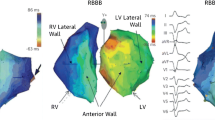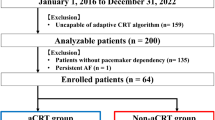Abstract
Purpose
Cardiac resynchronization therapy (CRT) improves outcomes in patients with heart failure, yet response rates are variable. We sought to determine whether physician-specified CRT programming was associated with improved outcomes.
Methods
Using data from the ALTITUDE remote follow-up cohort, we examined sensed atrioventricular (AV) and ventricular-to-ventricular (VV) programming and their associated outcomes in patients with de novo CRT from 2009–2010. Outcomes included arrhythmia burden, left ventricular (LV) pacing, and all-cause mortality at 4 years.
Results
We identified 5709 patients with de novo CRT devices; at the time of implant, 34 % (n = 1959) had entirely nominal settings programmed, 40 % (n = 2294) had only AV timing adjusted, 11 % (n = 604) had only VV timing adjusted, and 15 % (n = 852) had both AV and VV adjusted from nominal programming. Suboptimal LV pacing (<95 %) during follow-up was similar across groups; however, the proportion with atrial fibrillation (AF) burden >5 % was lowest in the AV-only adjusted group (17.9 %) and highest in the nominal (27.7 %) and VV-only adjusted (28.3 %) groups. Adjusted all-cause mortality was significantly higher among patients with non-nominal AV delay >120 vs. <120 ms (adjusted heart rate (HR) 1.28, p = 0.008) but similar when using the 180-ms cutoff (adjusted HR 1.13 for >180 vs. ≤180 ms, p = 0.4).
Conclusions
Nominal settings for de novo CRT implants are frequently altered, most commonly the AV delay. There is wide variability in reprogramming. Patients with nominal or AV-only adjustments appear to have favorable pacing and arrhythmia outcomes. Sensed AV delays less than 120 ms are associated with improved survival.





Similar content being viewed by others
References
Cleland, J. G., Daubert, J. C., Erdmann, E., Freemantle, N., Gras, D., Kappenberger, L., et al. (2005). The effect of cardiac resynchronization on morbidity and mortality in heart failure. The New England Journal of Medicine, 352(15), 1539–1549.
Dickstein, K., Vardas, P. E., Auricchio, A., Daubert, J. C., Linde, C., McMurray, J., et al. (2010). 2010 Focused update of ESC guidelines on device therapy in heart failure: an update of the 2008 ESC guidelines for the diagnosis and treatment of acute and chronic heart failure and the 2007 ESC guidelines for cardiac and resynchronization therapy. Developed with the special contribution of the Heart Failure Association and the European Heart Rhythm Association. Europace, 12(11), 1526–1536.
Hsu, J. C., Solomon, S. D., Bourgoun, M., McNitt, S., Goldenberg, I., Klein, H., et al. (2012). Predictors of super-response to cardiac resynchronization therapy and associated improvement in clinical outcome: the MADIT-CRT (Multicenter Automatic Defibrillator Implantation Trial with Cardiac Resynchronization Therapy) study. Journal of the American College of Cardiology, 59(25), 2366–2373.
Ritter, P., Padeletti, L., Gillio-Meina, L., & Gaggini, G. (1999). Determination of the optimal atrioventricular delay in DDD pacing. Comparison between echo and peak endocardial acceleration measurements. Europace, 1(2), 126–130.
Gold, M. R., Niazi, I., Giudici, M., Leman, R. B., Sturdivant, J. L., Kim, M. H., et al. (2007). A prospective comparison of AV delay programming methods for hemodynamic optimization during cardiac resynchronization therapy. Journal of Cardiovascular Electrophysiology, 18(5), 490–496.
Burri, H., Sunthorn, H., Somsen, A., Zaza, S., Fleury, E., Shah, D., et al. (2005). Optimizing sequential biventricular pacing using radionuclide ventriculography. Heart Rhythm, 2(9), 960–965.
Ellenbogen, K. A., Gold, M. R., Meyer, T. E., Fernndez Lozano, I., Mittal, S., Waggoner, A. D., et al. (2010). Primary results from the SmartDelay determined AV optimization: a comparison to other AV delay methods used in cardiac resynchronization therapy (SMART-AV) trial: a randomized trial comparing empirical, echocardiography-guided, and algorithmic atrioventricular delay programming in cardiac resynchronization therapy. Circulation, 122(25), 2660–2668.
Saxon, L. A., Hayes, D. L., Gilliam, F. R., Heidenreich, P. A., Day, J., Seth, M., et al. (2010). Long-term outcome after ICD and CRT implantation and influence of remote device follow-up: the ALTITUDE survival study. Circulation, 122(23), 2359–2367.
Kamdar, R., Frain, E., Warburton, F., Richmond, L., Mullan, V., Berriman, T., et al. (2010). A prospective comparison of echocardiography and device algorithms for atrioventricular and interventricular interval optimization in cardiac resynchronization therapy. Europace, 12(1), 84–91.
Mullens, W., Grimm, R. A., Verga, T., Dresing, T., Starling, R. C., Wilkoff, B. L., et al. (2009). Insights from a cardiac resynchronization optimization clinic as part of a heart failure disease management program. Journal of the American College of Cardiology, 53(9), 765–773.
Birnie, D., Lemke, B., Aonuma, K., Krum, H., Lee, K. L., Gasparini, M., et al. (2013). Clinical outcomes with synchronized left ventricular pacing: analysis of the adaptive CRT trial. Heart Rhythm, 10(9), 1368–1374.
Martin, D. O., Lemke, B., Birnie, D., Krum, H., Lee, K. L., Aonuma, K., et al. (2012). Investigation of a novel algorithm for synchronized left-ventricular pacing and ambulatory optimization of cardiac resynchronization therapy: results of the adaptive CRT trial. Heart Rhythm, 9(11), 1807–1814.
Brenyo, A., Kutyifa, V., Moss, A. J., Mathias, A., Barsheshet, A., Pouleur, A. C., et al. (2013). Atrioventricular delay programming and the benefit of cardiac resynchronization therapy in MADIT-CRT. Heart Rhythm, 10(8), 1136–1143.
Verdino, R. J. (2013). Goldilocks and the importance of AV intervals in cardiac resynchronization—how to best find the AV interval that is not too long, not too short, but just right for patients. Heart Rhythm, 10(8), 1144–1145.
Bogaard, M. D., Meine, M., Tuinenburg, A. E., Maskara, B., Loh, P., & Doevendans, P. A. (2012). Cardiac resynchronization therapy beyond nominal settings: who needs individual programming of the atrioventricular and interventricular delay? Europace, 14(12), 1746–1753.
Funck, R. C., Boriani, G., Manolis, A. S., Puererfellner, H., Mont, L., Tukkie, R., et al. (2008). The MINERVA study design and rationale: a controlled randomized trial to assess the clinical benefit of minimizing ventricular pacing in pacemaker patients with atrial tachyarrhythmias. American Heart Journal, 156(3), 445–451.
Funding sources
This analysis was conducted with support from Boston Scientific. Dr. Steinberg was funded by NIH T-32 training grant no. 5T32 HL 7101–38.
Conflict of interest
The following relationships exist related to this presentation: BS reports modest educational support from Medtronic; SW, PJ, and KS are employees of Boston Scientific; KJ reports research grant support from Medtronic; DH served in an advisory capacity of St. Jude Medical, Boston Scientific, Medtronic; speaks at educational venues of St. Jude Medical, Boston Scientific, Medtronic, Biotronik, and Sorin Medical; and is a steering committee member of St. Jude Medical, Medtronic; JD does not report any relevant disclosures; CF-M serves as a consultant to Boston Scientific; BP has received consulting fees from Boston Scientific; NV received research grants and consultancies from Biotronik, Boston Scientific, Medtronic, St. Jude Medical; JP reports receiving grants for clinical research from ARCA biopharma, Boston Scientific, GE Healthcare, Johnson & Johnson, and ResMed as well as consultancies to Janssen Scientific Affairs and Spectranetics.
Author information
Authors and Affiliations
Corresponding author
Rights and permissions
About this article
Cite this article
Steinberg, B.A., Wehrenberg, S., Jackson, K.P. et al. Atrioventricular and ventricular-to-ventricular programming in patients with cardiac resynchronization therapy: results from ALTITUDE. J Interv Card Electrophysiol 44, 279–287 (2015). https://doi.org/10.1007/s10840-015-0058-5
Received:
Accepted:
Published:
Issue Date:
DOI: https://doi.org/10.1007/s10840-015-0058-5




